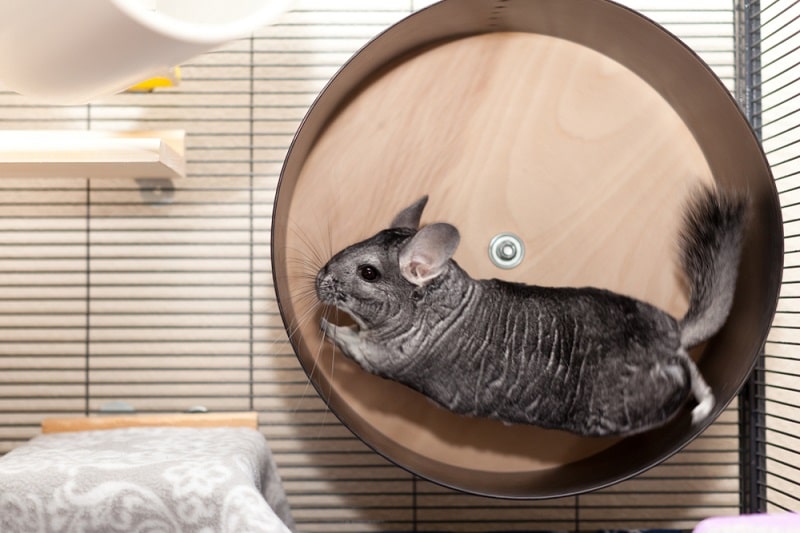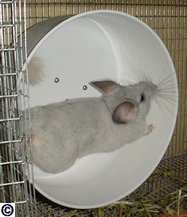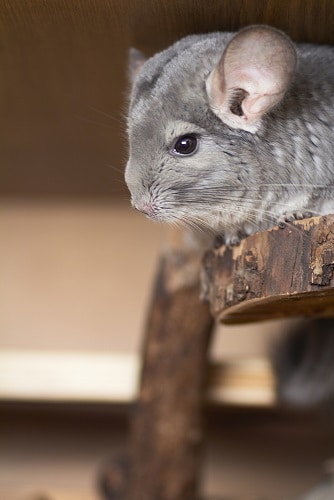
Chinchilla Exercise Wheels
A LARGE cage to accomodate running and playing, a variety of chew toys, a cage wheel, and TV during waking hours are all strongly recommended to keep your chin’s stress levels low and his intelligent mind occupied when he’s not actively engaged in out-of-cage exercise and interaction. Exercise balls are inadvisable for several reasons: their plastic construction, the largest size is still too small for most chinchillas, there is a strong possibility for overheating and if the chin pees, he’ll be rolling in his own urine.
Some chins, when nervous, stressed, or just not interested in being picked up, may run on the wheel as if they’re trying to “run away.” This is not caused for alarm, chins will NOT “run themselves to death” on an exercise wheel any more than during out-of-cage playtime, that is a care myth. If an extremely stressed chin uses a wheel and dies of acute shock (not a common problem, but it can happen) sometime later, it was not the wheel that caused his demise but the major, stressful event or change that he was unable to cope with. A pregnant chinchilla should have her exercise wheel removed about a week before littering, it can be returned after the kits are weaned or physically mature enough to use it safely. The pre-existing condition warning also applies to the use of exercise wheels.
It is very important to measure your chin’s cage door (unless the top can be opened) to ensure that the wheel can be put into the cage! An exercise wheel for the cage is definitely recommended, however, your chin will still require out-of-cage exercise time at least every other day for an hour each time. Playtime IS bonding time!
Be aware that wheels with a pronounced edge or “lip” around them (Leo Braun, Silver Surfer, etc.) may entice some chins to gnaw it, eventually wearing holes in the metal. To date, we haven’t heard of this causing any problem for the chin, but it does put some serious wear on the wheel.
If your chin doesn’t take to a wheel immediately, don’t assume that he just “doesn’t like” wheels and that the wheel is unnecessary. Be patient and give your chin a chance to adjust, because a chin who’s never had a wheel or a certain type of wheel can take a matter of weeks, maybe months, to try it and like it. It is very typical for chins to be reluctant or suspicious of change or of something that’s new or unfamiliar, whether it’s a change in diet, a new cage accessory, a bonding approach, etc. This means that a chin’s initial reaction, whether for positive or negative, should not be assumed to be his final opinion. The chinparent needs to allow their chin time to become familiar with something, to give it a fair chance, to adjust, to decide. It’s generally acknowledged that some chins, especially seniors, take longer to adapt to the Saucer Wheel, but we have found that once chins get the hang of it, they really take to the Saucer enthusiastically and often.
1. Running Surface
A running surface that is solid (NO rungs!) or made of wire mesh that is ½” X ½” or smaller, to prevent foot, leg, and toe injuries.
2. No Plastic
Plastic, either hard or soft, not only presents a serious choking hazard but is indigestible (e.g., the chin GI system can break down some woody plants, but not things like plastic) and can easily cause a FATAL intestinal blockage if accidentally swallowed.
3. Wheel Size
There is some debate as to whether a 12″ wheel could cause distress or injury to a chin’s back. When we asked our exotics specialist vet, she said no, that it wouldn’t cause any problems. And in the photo below, one of our smaller chins on the 12″ Leo Braun wheel, she is able to stretch out completely because the wheel is a full 12″ with the side open. HOWEVER, the small standing wheels with spokes that pet stores commonly sell are DEFINITELY NOT safe for a chin to run on, if not for the unnaturally cramped position that a chin must get in to use them, for the side spokes and runged running surface.

4. Spokes Are Lethal!
Spokes act like whirling blades when in motion on either side of the wheel, a chin that attempts to jump on or off a moving “suicide wheel” faces serious injury (snapped arms or legs), even death (broken neck). We know of people who’ve always used suicide wheels with their chins but that still doesn’t make these wheels “ok,” it only serves to show how smart chins are- that the chin carefully examined the wheel and how it works right from the start, perceived the risks inherent in using it, and proceeded with caution. Nevertheless, this is truly just an accident waiting to happen and it does indeed happen even with chins that have always used them, in the rescue work we’ve seen the amputees that result.
With a safe wheel, a chin will routinely jump on and off while the wheel is in motion, in fact, that’s sometimes part of the fun. Our boy Bear gets his wheel going until the screws at the inside center of his Leo Braun form a circle from the speed of the spinning wheel, then he jumps off and watches until the circle “disappears” and becomes just four screws again, which is his cue to jump back on. Chins that have previously enjoyed a safe wheel are particularly prone to suffer an accident when they try a suicide wheel because they’re not accustomed to the inherent dangers.
From a fellow rescue worker: “The lady who gave him to me [tripod] had him for 18 months and he went to her with all 4 legs… she said he had a rat wheel (the one that they go in and run with the bars), I said it would be best to remove it as chins have been known to slip and break a leg. She said he’s been ok in it for 2 days so she was leaving it there. Five days later she called saying he was at the vet getting his leg removed as he slipped!”
Wheel Suppliers
Traditional Wheel Style
- Chinchillas.com – 14″ The Original Silver Surfer Chinchilla Exercise Wheel
- Pinterest – Homemade Wheels
- Quality Cage Company – 15″ Chin Spin
- RodentLife Review – 14″ Quiet Heavy Duty Safety Wheels
The three sizes of Flying Saucer Wheel are explained on Meadowbrook Chinchilla’s (manufacturer) page, scroll to view. Standard size will accommodate a chin of any size, but the small size is ONLY for very small chins.
- Flower Town Chinchillas – Small size
- Meadowbrook Chinchillas – Small, Standard and Large/ Wheel care information, ball-bearing life and replacement
- Quality Cage Company – Standard size
Wheel Reviews & Demonstrations
- Makers of the Flying Saucer wheel Meadowbrook Chinchillas
- Photos, report on Chinchilla Go Round, Flying Saucer, Leo Braun wheels Darren’s Chinchilla Haven
- Photos, reviews of Leo Braun and Flying Saucer e-Rodent
Demonstrations: Movies of Chins on Wheels!
Using A Harness

The best harness type that I’ve found for chins has straps that go around the belly and neck and then connect along the back. Because of the belly strap, this is definitely not advisable for breeding females. You should practice often inside the house before taking them out for the first time, and not all chins will eventually adapt to a harness.
You can’t walk them as you would a dog, instead, follow them as they scout around. I’ve found that it’s a great way to have them along when I go for my walk- they love to look out, get fussed over by other walkers, and I don’t have to worry if they make a sudden jump, since they do get startled by strange noises.

